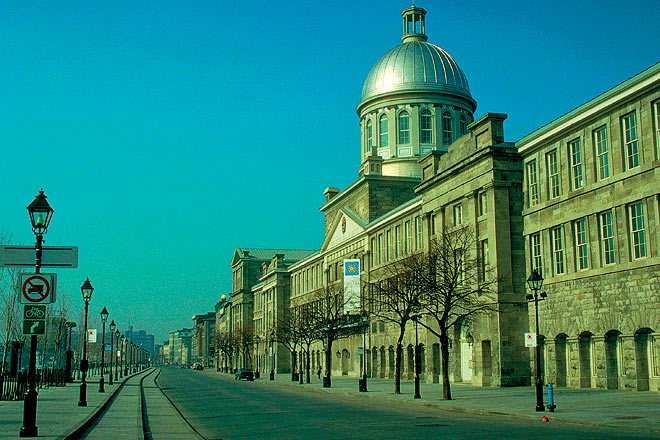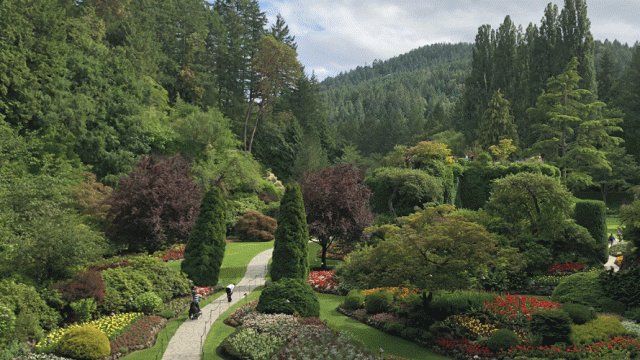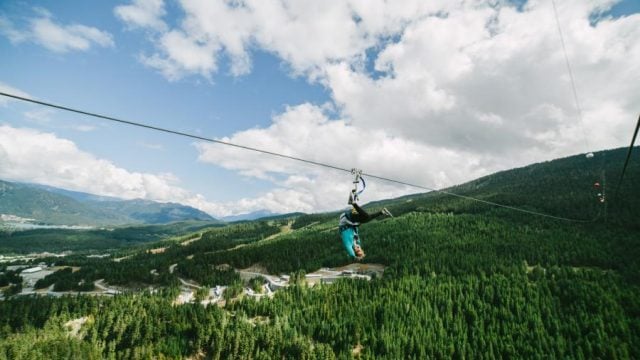In November, the maple leaves fell quivering to the ground in anticipation of winter. In a symphony

But it is not the first snow that heralds the official arrival of winter in Montreal. A blizzard may bury all the cars in sight as early as October or there may be no snow till January. In Montreal, winter doesn’t arrive because winter never quite leaves. It lurks on the edge of fleeting summers, waiting for November to begin draping its dark blanket over the city inch by inch, every inch a day that contains lesser and lesser light in it. The light extinguished, the day sky is an artist’s canvas of smudged charcoal. Slowly, Montreal fades to black and white. In the absence of colour, it is this stark, distinct shape that dominates the cityscape, imparting a grave and severe beauty to this city of 3.4 million on the Canadian east coast where French and British histories meld into a unique heritage.
A long-time resident of Montreal describes the winter landscape as a “scene from a Kurosawa movie, where we are the warriors”. Watching Montrealers—clad in puffy down jackets, snowshoes and balaclavas—navigate roads made slippery with ice, or battle expanses of fresh snow when it is difficult to tell street from sidewalk, I’m inclined to agree. But the temperatures are only just dipping. Every time a winter-hardened Montrealer catches me shivering, he or she has only one thing to say: “It will get worse.” In other words, the temperature will plummet from a daytime average of 7-11 degrees Celsius in November to 30 degrees below zero in January, the snow will pile up several feet and the wind will howl in your ears.
But if Montreal looks like a vast white wasteland on the surface, another city hides inside, like a pearl in an oyster shell. The challenge—and fun—of a winter holiday in Montreal is in discovering this explosive and vibrant inner city that is sexy, bohemian and très, très chic. Canada’s national daily, The Globe and Mail, calls Montreal the country’s “premier city, the only one that can even enter the shadow of a New York or Paris”. Montreal has both gloss and grit, owing in part to its identity as Canada’s fashion and design capital and also due to the fact that during the 19th and 20th centuries, the city was a hub of commerce. Its ethnic diversity is therefore not surprising: French, Irish, Scottish and English settlers drove the city’s economy as much as the Jews, Vietnamese and Chinese who came later. Although a separatist movement led by French-Canadians for an independent Quebec has periodically snapped at Montreal’s heels, the city’s cultural capital continues to draw heavy crowds, especially in the summer.
If you’re the type of traveller who likes a city free of the clutter and spill of camera-toting tourists, visit Montreal during the winter months, when its striking beauty, complemented by a wealth of architectural and cultural sights, are exclusively yours to see. Montreal is dotted with churches dating back to the early modern period, their narrow steeples jutting into the grey sky like sharpened pencils. Amidst the upright steeples stand the graceful sloping roofs of houses built by French and British colonialists. The city’s two major art and design museums located in the downtown area are showcases of both contemporary Canadian design and Inuit art. Considered the most European of all North American cities—given its colonial and ethnic heritage—Montreal is also Canada’s second-largest city after Toronto and one where cultural and social activities continue apace even as the days grow shorter. In fact, the achingly cold winter is the perfect setting for Montreal to reveal its true nature, which is open, liberal and as warm and sensuous as a satin-lined fur coat from Holt Renfrews, Montreal’s answer to Saks Fifth Avenue. Every winter month even has its own festival, including November’s Cinemania, a film festival showcasing independent French cinema, and January’s snow festival, the Fete des Neiges. If you dig snow, there is lots of it in and around Montreal for skiing, ice skating, snowboarding, sledding and tobogganing. A few thrill-seeking Montrealer friends claim that the joys of tobogganing down the slopes of Mont Royal on empty pizza boxes are unrivalled. It’s free and fun, they say, and no riskier than an accidental tumble in the snow.

It is also the allure of bohemia—a celebratory disorderliness, an indulgence of all things arty, the indefinable essence of joie de vivre—that makes this city so attractive. Mind you, this is not the bohemia of an earlier time, where material poverty and artistic richness were the hallmarks an ideal life. In Montreal, the bohemian slides in easily with the bourgeois; the bon vivant and the couturier often rub shoulders with struggling artists and musicians. In Plateau Mont-Royal, a grid of colourful streets to the east of downtown, such ironies coexist aplenty. High-end stores selling clothing made to look grungy nudge hangars that sell authentic thrift-store stuff. In the Plateau’s residential areas, one-room artist studios share green spaces with upper-middle-class homes. As you go east of the Plateau, Montreal’s colourful gay village will beckon the interested traveller with its gay bars and clubs.
The Plateau has a number of quaint bars and restaurants that serve as stages for Montreal’s local jazz and rock bands; the city’s bohemian reputation is also an invitation for independent bands from all over. On any given evening, you will be treated to feisty (if somewhat choppy) performances as you sip one of the creative and delightful martinis that Montreal’s bars are famous for. Fickle New Yorkers, always in search of new hedonisms, often make the five-hour drive to Montreal for an evening of jazz and martinis. Montrealers, however, are avowed beer drinkers and pub menus can list anywhere up to twenty special brews from Quebec’s microbreweries.
Once, at midnight, a few friends dragged me out in minus 2 degree weather to pub crawl. As we walked down Crescent Street, a hip strip of restaurants, bars, stores and nightclubs, I couldn’t help gawping at the serpentine queues, all waiting to get in. Obviously, Montreal’s free spirit is irrepressible by the inclement forces of winter. If anything, winter brings out a certain kind of defiance in Montrealers, an unwillingness to let the biting cold bring an end to the party. The streets are busy till 2am with partygoers and pub-crawlers, hookers and strollers, all swaying to the cadence of some unknown festive beat. Montreal’s innumerable downtown lounge bars, strip clubs and pubs are packed to bursting with beautiful girls with little else but maquillage on, accompanied by elegant men in pinstripes and carefully constructed out-of-bed hair.

Away from the heave and sway of the dance floors, restaurants and food kiosks do brisk business. Given its multiethnic population, Montreal is home to diverse cuisines, and you can often sample outstanding food at very reasonable prices. Steamed delicacies from Chinatown, sweet BBQ pork from subterranean food courts, shish taouk and kebabs from Lebanese corner stores, Tonkinoise soup, Greek souvlaki, French bistro cuisine and Korean bulgoki—it’s all available for as little as CAD $10!
But one of Montreal’s favourite winter foods is a unique Quebecois goulash called poutine – a calorie-rich dish of thick-cut French fries with gravy and cheese curds. Though I had vowed to stay off the stuff, my brother’s prophetic words came back to me as I sat at a café one night. Having spent his student days here, he knew all about the life-affirming qualities of greasy, gooey poutine. “Wait till it’s freezing cold and you’re drunk, cold and hungry at three in the morning,” he said. On that December night when the temperature hit 10 below zero, I discarded the civility of fork and knife for the convenience of fingers and fell upon that bowl of poutine as if it were the last remaining source of heat and nourishment, of taste and pleasure. Outside, Christmas lights winked as I decided that I could happily do a Montreal winter again.
The information
Getting there
Air Canada, Lufthansa and British all fly to Montreal. Ticket prices may range from â?¹70,000 to â?¹1,00,000
Getting around
Walk. Cabs are not too expensive, underground subway only serves a limited area, but extended bus service, 24-hour. If you need to rent a car, there’s Avis (514-866-7906/1-800-321-3652, www.avis.ca). Tourist transit passes are available for use on all public transport (514-280-5507, www.stm.info).
Where to stay
Luxury: Le Meridien Versailles-Montreal on Sherbrooke St West, an elegant hotel in the centre of downtown (www.versailleshotels.com). Le Square Phillips Hotel & Suites, further south into downtown, four-star, very close to shopping centres (www.squarephillips.com).
Mid-range: L’Appartement Hotel on Sherbrooke St West offers renovated and fully furnished studios, including kitchenettes (www.appartementhotel.com). Days Inn Montreal, a three-star hotel located close to Chinatown and Old Montreal (www.daysinnmontreal.com).
Budget: Hotel de Paris, a quaint and small hotel housed in a historic building, on Sherbrooke St East (www.hotel-montreal.com). Hotel Quartier-Latin, a B&B on St-Denis, a street with some of the city’s best restaurants, close to the historic sights of Old Montreal (www.hotel-quartierlatin.com).
Where to eat
L’Academie and Aus Bistro Gourmet Deux for fabulous French bistro cuisine at reasonable rates. On St. Denis. L’Academie has long queues every day of the year and they don’t make reservations after 5pm, so go early.
Premier Moisson Boulangerie on Sherbrooke St West: This little basement bakery has the best European pastries and cakes, homemade chocolate and condiments, crusty French breads, pates and cheeses. Although it is a little pricey, it’s worth every dollar.
Eaton Centre food court: A range of foods, including Korean, Japanese, Mexican, Greek, etc. Meals are cheap, but a bit on the greasy side.
Schwartz’s Hebrew deli: On St. Laurent Blvd, this deli is an important landmark in Montreal. Don’t miss their famous smoked meat sandwiches. Open late, but the queues are long at peak hours, so I prefer takeaways. Celine Dion visits often.
Poutine: Available at any fast-food store, including Burger King! Try any of the La Belle Province (Quebec’s own fast food chain) outlets for poutine.
What to do during the day
Museums: Visit the unique Just for Laughs museum, which has an International Comedy Hall of Fame and watch the 100 best clips from the world’s 100 best comics. For details visit www.hahaha.com. Montreal Museum of Fine Arts on Sherbrooke Street has free entry to its permanent collection, which has both Renaissance and contemporary Canadian art. It’s on both sides of the street, with an underground passageway, so set aside about three hours for a dekko (www.mmfa.qc.ca). The Canadian Centre for Architecture, on Baile Street, houses a museum dedicated to architecture. The McCord Museum of Canadian History on Sherbrooke holds Montreal’s history, and directly opposite it sits the 80-acre campus of McGill University, one of Canada’s premier academic institutions. You could also hop over to the Redpath Museum on the McGill campus for an understanding of Quebec’s natural history.
Churches: The Church of St Andrew and St Paul, a Presbyterian church, is close to the MMFA and has beautiful stained glass windows and grey stone. Further south, on the corner of Peel Street and de La Gauchetiere Street is St George’s Anglican Church, a neo-Gothic structure with some beautiful woodwork inside. The Mary Queen of the World Cathedral, on Rene Levesque Blvd, is interesting for its paintings depicting the beginnings of Montreal.
Montreal Biodome and Olympic Tower: The Biodome has four natural ecosystems on show – tropical, marine, Laurentian (Quebec) and polar – with wildlife in their natural habitats. Next door is the Olympic Park, built for the 1976 Olympic Games in Montreal and the Insectarium.
Markets: The Jean Talon Market in the Little Italy district sells local produce such as Quebec cheeses, maple syrup, cider and more. The covered (and heated) market at Atwater also sells artisan foodstuffs unique to the region.
Old Montreal and Chinatown: Old Montreal is home to some of the city’s historic buildings, and was the seat of the French colonial government. On the banks of the St Lawrence river, the area has been converted into a tourist-friendly patch of restaurants, museums, cafes and stores selling Quebecois handicrafts and arts. Good to stroll about. Close by is Montreal’s Chinatown, which, though small, has a couple of streets with stores worth browsing through.
St Laurent Blvd and St-Denis: These arterial north-south streets give Montreal its hip and sexy image, with lots of funky clothing and furniture stores, restaurants, and L’Androgyne, a bookstore devoted to gay literature.
What to do at night
Cavalli on Peel Street is where corporate types let their hair down. Thursday evenings are huge at this two floor lounge. Don’t miss the centerpiece – a psychedelic pink bar! Also does great, but expensive lunches. Club 737 at 1, Place Ville-Marie is an upscale and chic nightclub located in a high-rise that offers the most gorgeous view of city lights. Rub shoulders with the swish set in this elegant and large club with two floors. Jello Bar on Ontario St east has a menu of more than 50 martinis. Daily live acts, retro-chic décor. Luba Lounge on Bleury St has delicious chocolate martinis, though the lounge feels more like a living room. Beers are best had at Brutopia or Hurley’s Irish Pub, both on Crescent St. Else’s on Roy St east in Plateau Mont Royal is a smoke-filled hangout with great scotch, beers and pub food.
Where to shop
Sainte-Catherine Street, a 15-km stretch of high-end stores and malls. Montreal’s underground city, a 33-km pedestrian network with shopping complexes, restaurants, movie halls and subway stops, is always abuzz during the day. Shopaholics will delight in the underground stretch of 300 stores on Sainte-Catherine, Eaton Center, Place Montreal Trust and Complexe Les Ailes. Laurier St on Plateau Mont-Royal is another street with high-end designer stores, but the other streets on the Plateau have more offbeat clothing, books, furniture and bric-a-brac.
Winter festivals
Organised by the Museum of Contemporary Art, Cinemania showcases independent French cinema every November. Everything is subtitled! Fete des neiges (usually January-February) is held in the Parc Jean-Drapeau, and continues over three consecutive weekends. The best way to get a feel for the winter in Montreal. It is a fairytale realm – a snow castle dominates the centre of the outdoor festival, you can actually explore the castle which is populated with medieval characters. Try ice climbing from professional climbers. Artapalooza! is a theatre, music, mime and dance festival aimed at young crowds, with performances and workshops in French and English.
Cinemania
film festivals
Montreal





